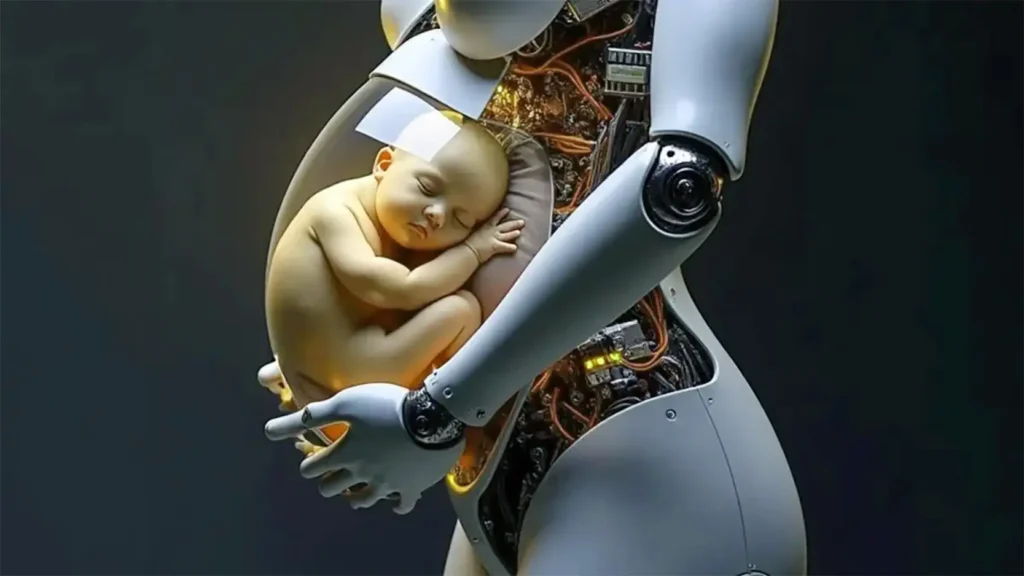For as long as people have imagined robots, they’ve pictured machines built in factories—welded, assembled, and programmed to follow orders. However, a new idea is quietly changing that picture: artificial birth technology for robots. Instead of being constructed on a line, robots might one day be born, grow, and even evolve, much like humans or animals.
It sounds strange at first, but researchers are serious. The ambition is not to make robots look human, but to give them something closer to life-like development and adaptability.
What Exactly Is Artificial Robot Birth?
The concept is inspired by nature itself. In simple terms, it’s the idea that machines could be created in ways that mimic biological birth. Instead of humans putting together metal parts, the robot would form, grow, and perhaps even self-assemble.
This approach combines several fields: robotics, biotechnology, and advanced AI. Using 3D bio-printing, neuromorphic chips, and self-organising algorithms, scientists are exploring how machines might emerge instead of being assembled like furniture.
The Science Pushing It Forward
A few key technologies are shaping this field:
- Neuromorphic computing which mimics the human brain.
- Synthetic tissues and artificial skin, printed through advanced 3D methods.
- Evolutionary AI, where machines can inherit traits and improve over generations.
- Synthetic biological intelligence (SBI), blends biology with robotics.
Each breakthrough moves us a little closer to machines that not only exist but also develop.
Why It Could Change Everything
Robots born in this way wouldn’t just be tools. They’d be machines that learn, adapt, and interact far more naturally than today’s industrial robots.
Some possible advantages:
- They could communicate with humans in ways that feel more authentic.
- They might repair or regenerate themselves, lowering maintenance costs.
- Future generations of robots could be smarter and more efficient than their predecessors.
- The process could cut down on waste, offering a more sustainable approach than mass assembly lines.
This isn’t just about building better robots. It’s about creating machines that feel less artificial and more like companions, partners, or explorers.
Potential Uses of Human-Like Robots
The applications are wide-ranging:
- Healthcare – Lifelike carers assisting patients or the elderly with compassion and precision.
- Space missions – Self-replicating robots could survive and adapt where humans cannot.
- Education – Machines that teach with emotional understanding, offering children personalised guidance.
- Industry – Factories powered by robots that heal themselves instead of breaking down.
- Security – Adaptive robots capable of responding to threats in real time.
The Ethical Questions
Of course, this technology raises unsettling questions. If a robot can be born, grow, and even feel emotions, does it deserve rights? At what point does a machine stop being property and start becoming something else?
There’s also the human side. If lifelike robots can do most jobs, what happens to employment? How do societies adjust? And most importantly, how do we ensure these machines stay aligned with human values rather than drifting away from them?
Obstacles Still in the Way
Despite the excitement, we’re still far from reality. Major challenges remain:
- Combining living tissues with robotics is unpredictable.
- Powering machines that mimic biological growth is unsolved.
- Emotional intelligence in AI is still in its early stages.
- No clear global rules exist to regulate this field.
In short, it’s possible—but still experimental.
Looking Ahead
Even so, progress is happening. Scientists are testing ideas like artificial wombs for robotic embryos, coding systems that behave like digital DNA, and materials that heal themselves when damaged.
The dream is to create machines that don’t just serve us, but grow alongside us, learning and adapting in ways that blur the line between life and technology.
Conclusion:-
Artificial robot birth technology could redefine what it means to build a machine. Instead of being manufactured, robots of the future might be brought into existence—machines capable of learning, healing, and even evolving.
It’s a thrilling, unsettling, and deeply transformative vision. One that could reshape healthcare, education, exploration, and industry. But it also forces us to confront big questions about identity, ethics, and the role of machines in human life.
We may not be there yet, but the first steps have already been taken. The future of robots might not be in factories—it might be in something that looks a lot more like birth.


2 Responses
I enjoyed reading this article. Thanks for sharing your insights.
Thank you so much! 😊 I’m really glad you enjoyed it. It means a lot that you took the time to read and share your thoughts — appreciate the kind words!